Explore the Cathedral site and find your way around.
We are committed to becoming carbon neutral and recognise the Christian duty to care for God’s creation.
We are committed to becoming carbon neutral and recognise the Christian duty to care for God’s creation.

We offer a number of unique venues for private hire. From meetings and corporate entertaining to private dining, receptions and concerts - we can help you create your perfect event.
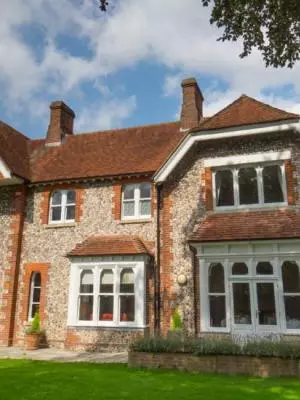
Preserve the heartbeat of Chichester Cathedral – find out more about the Platinum Endowment Trust for Music.

Our Guides offer tours of the Cathedral at 11.30am and 2.30pm Monday to Saturday inclusive. Step into iconic moments of English history, from the Roman market city of Chichester, to the Civil War and siege of the city.
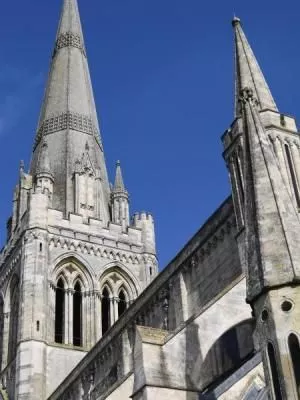
Explore our vibrant programme celebrating 950 years of Chichester Cathedral

Chichester Cathedral boasts a vibrant musical tradition, anchored by its world-renowned choir, offering prestigious Organ Scholarships and welcoming visiting choirs.

Explore the Cathedral site and find your way around.
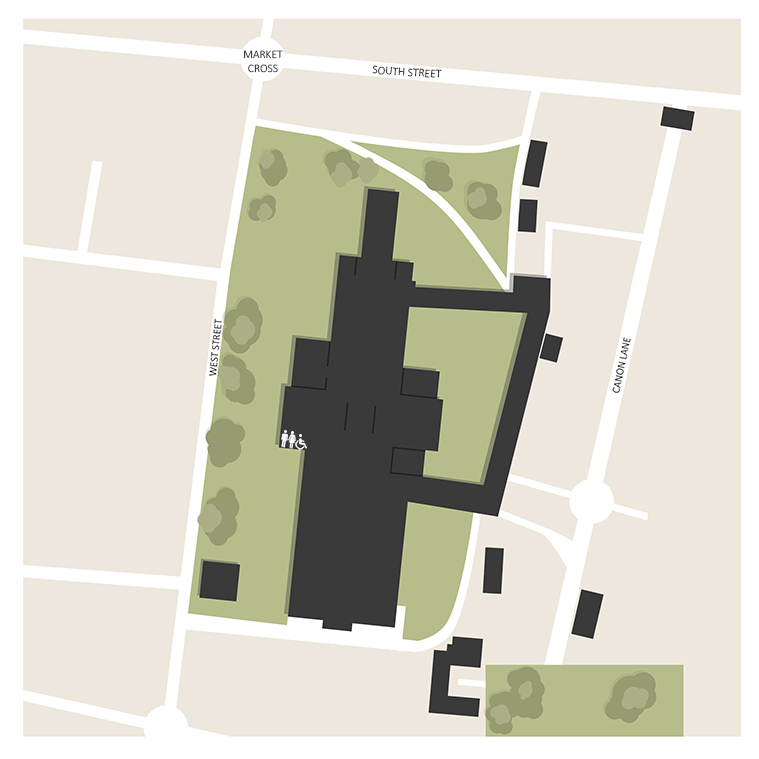

Chichester is the only English Cathedral with a surviving detached medieval Bell Tower, or ‘campanile’; it dates from around 1400. The tower is in regular use by the Cathedral’s bell ringers and the Bell Tower Drop-in project which provides an activity space for children after school. The historic Bell Tower is in need of restoration and was added to the Heritage at Risk Register in 2016.

Located outside Chichester Cathedral, at its northwest corner, stands a larger than life-size bronze statue of a cloaked St. Richard, created by Philip Jackson.
In his left hand St. Richard grasps both a roped scourge, a symbol of self-discipline, and the edge of his cloak. His outstretched right arm makes the sign of a holy blessing.
The plinth on which St. Richard stands is made up of Trevonite granite from Cornwall and blue Welsh slate and is topped by a layer of Portland limestone. It was commissioned by the Friends of Chichester Cathedral as part of the Millennium celebrations and unveiled on 15 June 2000.

Admission to Chichester Cathedral is by donation. The recommended donation is £5.00 per person. As an independent charity we rely on your support, as we receive no automatic funding from the Government or Church of England. Your donation will keep this Cathedral free for everyone, and open for generations to come.
Groups of any size are invited to explore the Cathedral. Groups of 6 or over are asked to pre-book so that we can make sure the Cathedral is available for your visit, whether that be self-guided or with one of our expert Guides. Please note that there is a booking charge for groups. Find out more>>
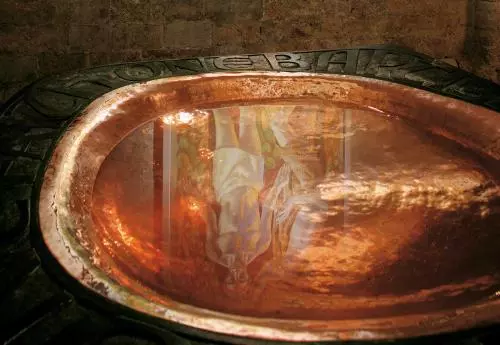
Situated in the south-west tower, the Baptistry is home to a wonderful copper font used for baptisms. Commissioned by the Dean and Chapter and dedicated in 1983, the font is the work of British sculptor John Skelton. The painting, The Baptism of Christ, is by Hans Feibusch and was painted in 1951. Find out more here.
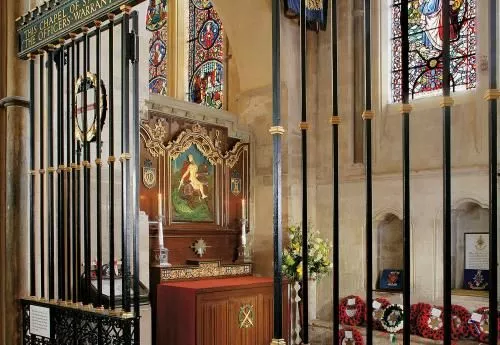
In the South Aisle, the Chapel of St George was restored in 1921 as the memorial chapel of the Royal Sussex Regiment. Recorded on panels around the walls are the names of almost 8000 soldiers from the regiment who tragically fell in World War I. Find out more here.

Restored in 1898, the Chapel of St Clement is dedicated to the 3rd Bishop of Rome, who died at the end of the first century.
The chapel was built around 1300 and is still used daily for morning prayers and other periodic services.
The altarpiece The Icon of Divine Light (1973) is by Cecil Collins; it presents God as a burst of sunlight, surrounded by smaller stars resting in its warm glow. Find out more here.
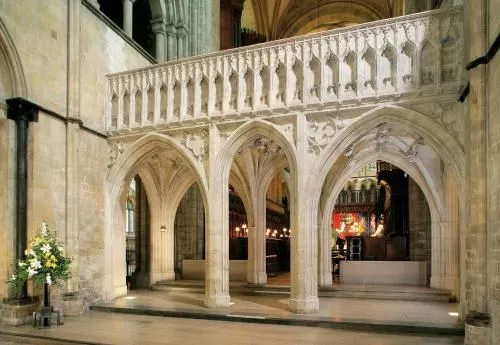
Originally built in the fifteenth century as a way to separate the Nave from the Quire, the Arundel Screen was removed by the Victorians in 1859 in order to open up the space. This revealed cracks in the masonry leading to the subsequent fall of the spire in 1861. After being held in storage for one hundred years, the Screen was reinstated to its original location in 1961. Find out more here.
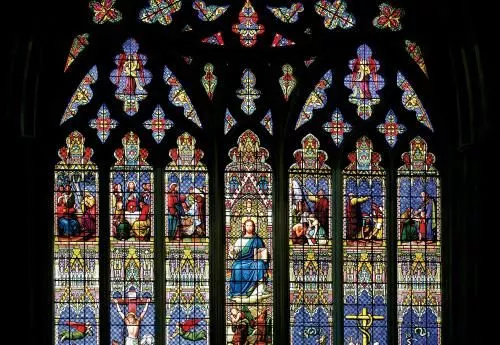
The South Transept is dominated by a huge window; the glass dates from 1877 and depicts scenes from both the Old and New Testament.
The large painted wooden panels on the west wall are of national importance; painted in the 1530s by local artist Lambert Barnard, these Tudor Charter paintings are believed to be the largest surviving paintings of their kind. They depict two historic moments in the Cathedral’s life: its sixth-century origins; and a then-contemporary depiction of Henry VIII guaranteeing the protection of its future. Find out more here.

Discovered in 1829 behind the woodwork of the choir stalls, these two carved stones have been dated to the second quarter of the 12th century, making them one of the earliest pieces of art in the Cathedral. They depict two scenes, Christ arriving in Bethany and the Raising of Lazarus, and are currently on display in the South Nave Aisle. Find out more here.
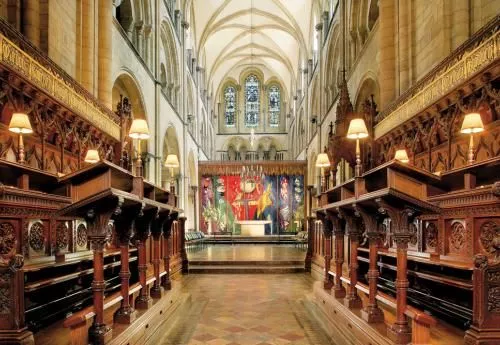
This part of the Cathedral is the heart of its sung services. The three-tiered wooden stalls are beautifully carved and date from the 1330s; they retain much of their original fabric, with some nineteenth century restoration. The Quire is in current everyday use by the clergy and the Cathedral Choir and is the setting for the daily Evensong service. Find out more about the Quire here.
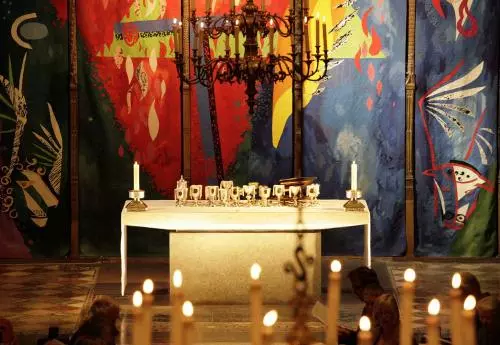
Considered the spiritual heart of a church, the High Altar represents the ‘Holy Table’, a sacred place for gifts and prayers to be offered to God.
The tapestry, set behind the High Altar, is a vibrant focal point drawing the gaze of visitors as soon as they enter the Cathedral. Commissioned by Dean Hussey, the tapestry was installed in 1966 and is by the British artist John Piper. It consists of seven panels, each 1 metre wide and 5 metres high. Using bold colours and striking imagery the central subject is the Holy Trinity, to which the Cathedral is dedicated. Find out more here.
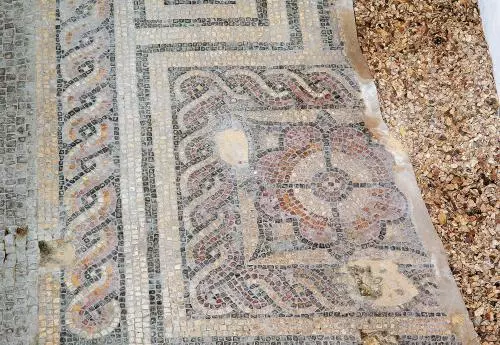
Excavations suggest that underneath the centre and eastern end of the Cathedral once stood a large Roman house. Parts of this structure’s mosaic tiled flooring can be viewed under a glass walkway, in the South Aisle.
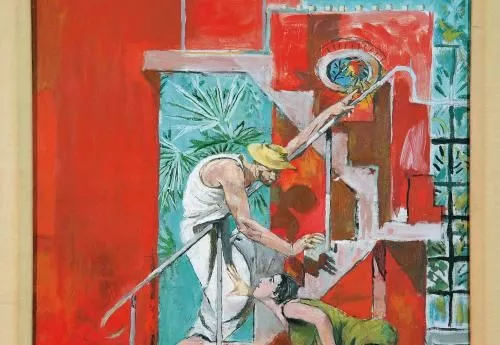
Installed in the St Mary Magdalene Chapel, Graham Sutherland’s painting Noli me Tangere (Do not hold me) was painted in 1961 and is a powerful depiction of Jesus’ return to life after the crucifixion. Find out more here.
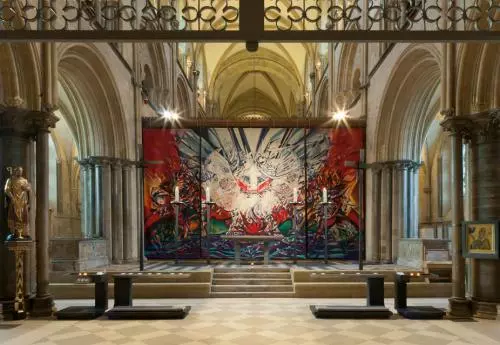
The Shrine of St Richard, our own Saint and a Bishop here in the 13th century, was one of the most important for pilgrims to visit during the medieval period. Today, thousands of people still come each year to pray at the Shrine.
The large tapestry is by the German artist Ursula Benker-Schirmer and co-created with students from West Dean College, near Chichester. This vibrant tapestry contains symbols, biblical in origin, relating to the life of St Richard.
The Icon of St Richard, positioned above the candle stand, was paid for by the Chichester Cathedral Friends and created by the artist Sergei Fyodorov, one of the foremost living icon-painters. The painting depicts Richard with his hand raised in blessing towards the viewer. Find out more here.

Created in 1968 by the sculptor Philip Jackson, the bronze statue of ‘Christ in Judgement’ is positioned in the Retroquire above the entrance to the Lady Chapel. The subject of the statue is the final judgement of the world by Jesus, a popular theme in religious art pieces. Find out more here.
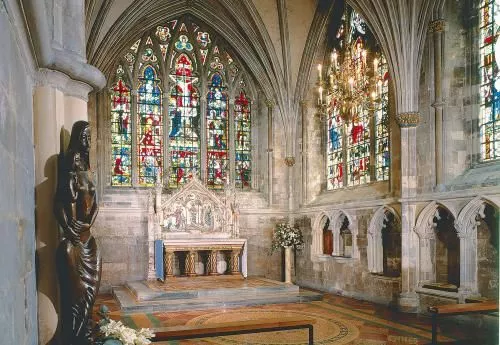
The Lady Chapel is one of the most tranquil areas within the Cathedral. It is set aside for prayer, and so is often sought out by visitors and worshippers who want to spend a little time in quietness and reflection.
The bronze sculpture 'Virgin and Child' is by the Sussex sculptor John Skelton (1923 - 1999), who also designed the Cathedral’s font in the Baptistry. Find out more here.

The Chapel of St John the Baptist is home to a Reredos (the painting above the altar) by Patrick Procktor, an English artist of the late 20th Century. It was added to the chapel in 1984 and depicts St John baptising Jesus. In the painting, St John’s extended right arm offers an invitation to all to participate. Find out more here.
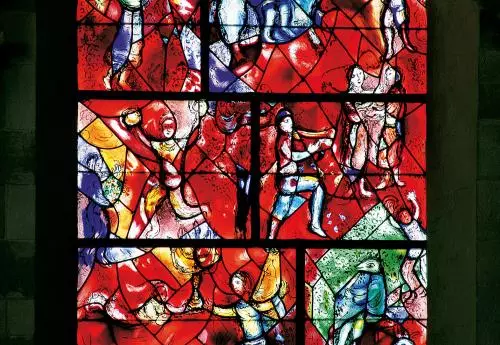
This is one of the Cathedral's most famous artworks. This glorious window was installed in 1978.
From initial meetings between the Cathedral’s Dean Hussey and the Russian-born painter, it took nine years before the piece was finally unveiled. The strong colours and often unusual imagery contained in the stained glass are a celebratory representation of Psalm 150: “O praise God in his holiness… let everything that hath breath praise the Lord”. Find out more here.
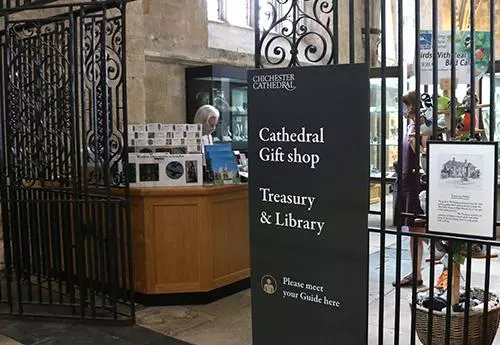
Located in the Treasury alongside a fine collection of items on loan from churches throughout Sussex, as well as other pieces used in the life of the Cathedral is the Cathedral Shop. Whether you’re looking for a special memento of your visit to Chichester Cathedral or that perfect gift for a loved one – we will have something to catch your interest.
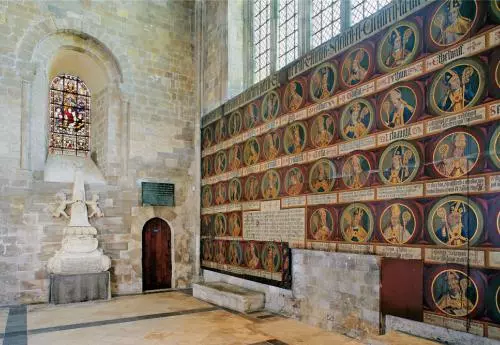
This space was originally part of a pre-Cathedral church dedicated to St Peter. The North Transept is now home to a second set of Tudor paintings by the artist Lambert Barnard, who also created the large Tudor paintings in the South Transept.
The paintings are ‘representations’ of the Bishops of Chichester but all have similar features – the features are those of Bishop Robert Sherborne who commissioned the painting in the 1530s. Lambert Barnard was Sherborne’s court painter, so this was probably an act of flattery. Both sets of paintings are considered to be of exceptional importance to the nation’s Tudor heritage. Find out more here.
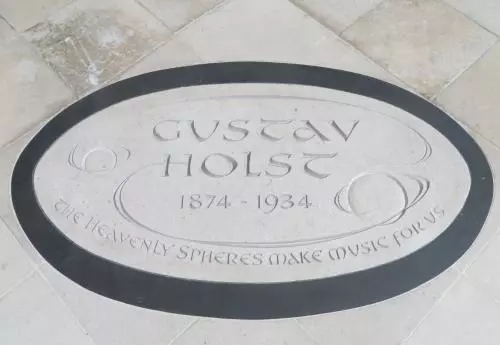
One of the greatest figures in British 20th century music, Gustav Holst had a special connection to Chichester Cathedral. The composer, who wrote The Planets suite, was a friend of Chichester's Bishop Bell and worked with him on the Whitsuntide Festivals. Holst died in 1934, before winning international recognition for his work. On his death, his ashes were buried in the North Transept underneath a memorial to his favourite Tudor composer, Thomas Weelkes. The memorial to Holst was installed and dedicated in 2009, and reads: 'The Heavenly Spheres make music for us.'
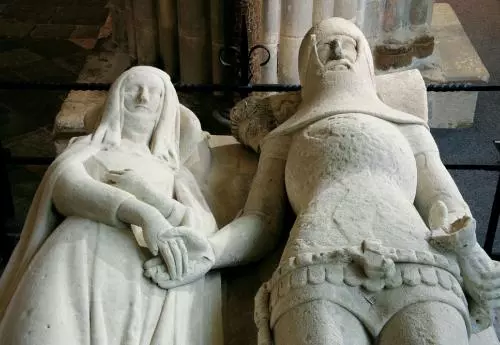
The Arundel Tomb in the north aisle of Chichester Cathedral was brought from Lewes Priory after its dissolution in 1537. It is a tomb chest and on top lays the recumbent figures of Richard Fitzalan, 2nd Earl of Arundel, and his wife, Eleanor of Lancaster – they are gently holding hands. The tomb is best known today for inspiring Philip Larkin’s 1955 poem, An Arundel Tomb and its touching final line ‘What will survive of us is love’. Find out more here.

Also known as The Sailors’ Chapel, The Chapel of St Michael is a memorial to the Royal Navy and the people of West Sussex who gave their lives at sea in World War II. It was dedicated by Queen Elizabeth 2nd and the Duke of Edinburgh in July 1956. The Chapel was substantially refurbished and re-dedicated in 2017 thanks to a generous bequest and money from the Chichester Cathedral Friends. Find out more here.
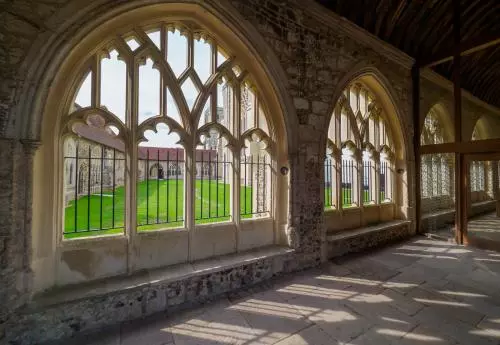
Built in the 15th century, Chichester Cathedral’s historic Cloisters have been a busy thoroughfare for over 600 years. As well as providing covered passage for clergy and worshippers, the Cloisters extend the visitors’ experience to the historic Cathedral Close and the beautiful Bishop’s Palace Gardens.

Enclosed within the Cloisters lies Paradise, the central area. Paradise is a living churchyard and place of burial, and is open daily as a place of quiet reflection. In this space you are invited to remember those ‘whom you love, but see no longer’.
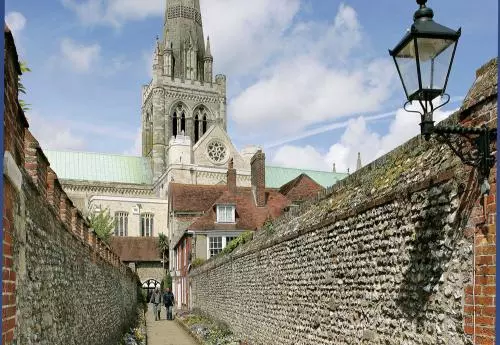
This picturesque pathway invites you to follow in the footsteps of pilgrims from across the ages – for centuries, this route has used by pilgrims to approach the Cathedral. St Richard’s Walk gives a fine view of the Cathedral spire, and in the other direction, the Deanery, one of the finest Georgian houses in Chichester, built in 1725.
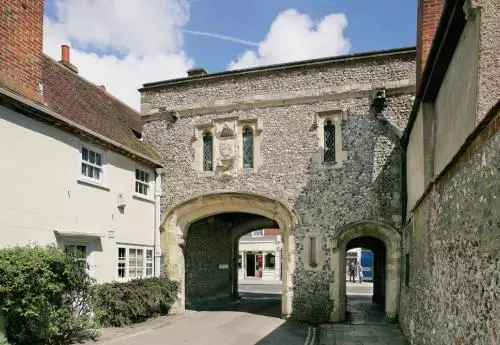
Running parallel to the city’s West Street, on the southern side of the Cathedral, Canon Lane connects Chichester’s South Street to the Bishop’s Palace and Gardens.
This historic lane has evocative medieval arches at either end, and contains many of the Cathedral’s listed buildings. The Cathedral’s governing body are the custodians of a number of properties that make up this 'historic Cathedral quarter' of the city.
Paths leading off from Canon Lane - Vicars’ Close and St Richard’s Walk - join up and give access to the Cathedral Cloisters.
Canon Lane is also home to one of our self-catering accommodation apartments, located above the historic gateway to the Cathedral Close. Find out more here

This former archdeaconry has been beautifully restored to accommodate eight en-suite bedrooms offering bed and breakfast. The house can also be hired for retreats, meetings, functions and weddings. This is a very special venue, nestled in the peaceful and beautiful Cathedral Close but also right in the middle of the city, just steps away from all that it offers.

These gorgeous gardens offer an oasis in the city centre. The gardens date back to 1147 and have recently benefited from a major refurbishment. Open from 8am until dusk, the gardens are just a short stroll from the Cathedral.
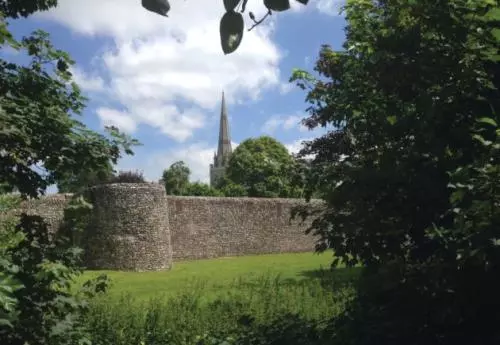
1800 years after they were first built, the Roman walls of Noviomagus Reginorum remain largely in place. The Cathedral is positioned in the south-west corner of the encircling wall, the majority of which remains available to walk in the Bishop’s Palace Gardens.
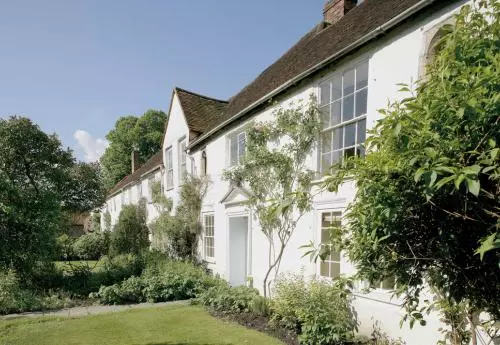
Close to the South Street end of Canon Lane, Vicars’ Close connects travellers to the Cathedral Cloisters via a picture perfect row of terraced houses. These houses were once the homes of the ‘Vicars’ Choral’, deputies to the Canons who governed the Cathedral.
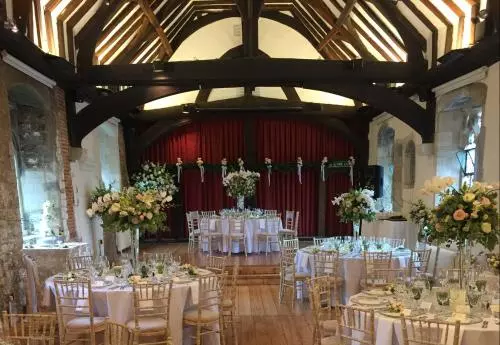
Adjacent to the Cathedral Green, and at the top of Vicars’ Close, stands Vicars’ Hall. This atmospheric medieval hall was once the meeting place of the ‘Vicars’ Choral’ who lived in Vicars’ Close and worked for the Cathedral Canons. Vicars’ Hall is still a much-used meeting place for Cathedral and community functions, and this historic venue is also available for private hire.
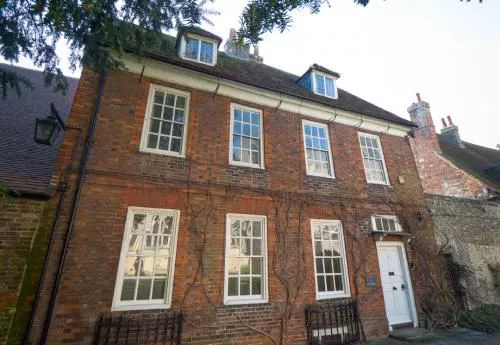
A beautifully restored Georgian Grade II listed house, conveniently located on the Cathedral Green in the centre of Chichester. Formerly on the site of the historic St Faith's Chapel the accommodation comprises of a spacious living, four bedrooms, two bathrooms and a well-equipped kitchen. Find out more here.
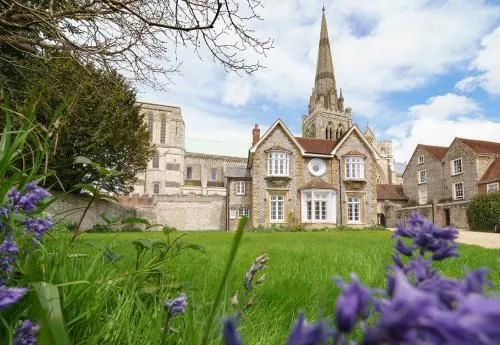
Located just off the Cathedral’s Cloisters, these spacious and newly refurbished suites have stunning views of the Cathedral and the grounds. A perfect place to relax after a day exploring the Cathedral and dinner in the city.
For general enquiries, email info@chichestercathedral.org.uk and a member of staff will get in touch, or visit our contact page.
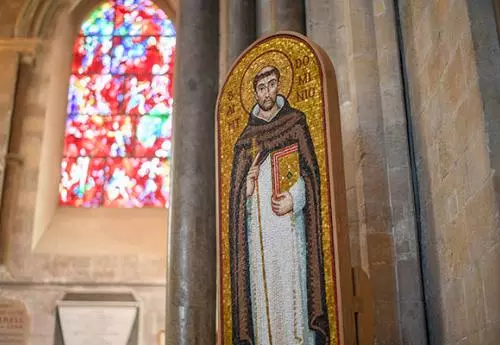
The mosaic of Saint Dominic is made of glass from Murano, Venice. The glass tesserae are cut and set into wet lime plaster as a working surface, before being set permanently into mortar. Saint Dominic is shown with bare feet, carrying a crossed staff, signifying his itinerant life. He also carries a copy of the gospels from which he preached. The vestments he wears, for the Dominican order, were developed in his own lifetime.
Level access into the Cathedral is available through the South West Door. Within the Cathedral and the Cathedral precincts there are ramps for easy level access.